
MEXICAN RIVIERA
Cabo San Lucas is not part of the Mexican Riviera. We've put a few pictures of our stay in Cabo on this page because: a) it is the port from which we departed for the Riviera, and b), we didn't have the pictures of Cabo editted and ready to put in the Baja page when we created it.
The craggy arches in the photo below are known as Los Arcos and the beach on this side of the narrow peninsula is known as Divorce Beach. We think it got its name as a joke because the more famous beach on the other side is called Lover's Beach.
Tourists hire a boat to bring them out to Lover's Beach. It's a great place to sunbathe, swim and snorkel.
The city of Cabo San Lucas is just out of sight behind Los Arcos and to the left.

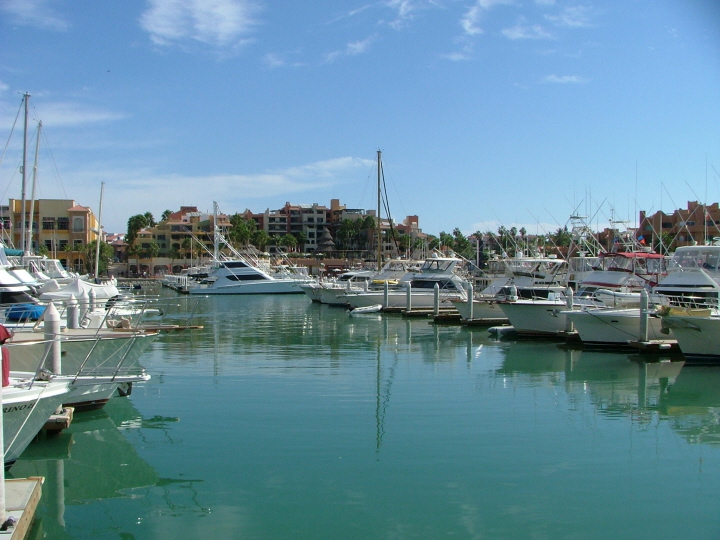
After living "on the hook" (at anchor) for several weeks, with a mountain of laundry to be done, and water tanks to be filled. We decided to treat ourselves and spend a couple of nights in the incredibly expensive Cabo Marina. It's not that much different than a lot of nice marinas, it just doesn't have any competition and it is in a fairly remote location, a long way from any other major population center. Consequently, the moorage rates are kept as high as the traffic will bear, and for the moment, reservations are usually required to get a slip.
We expected it to be noisy at night with all the restaurants and bars surrounding us, but we were fortunate in being assigned a slip near the outer end of the dock and it was very quiet. Kavenga's mast is the one just to the right of center.
(It was $2.75/foot/night.)
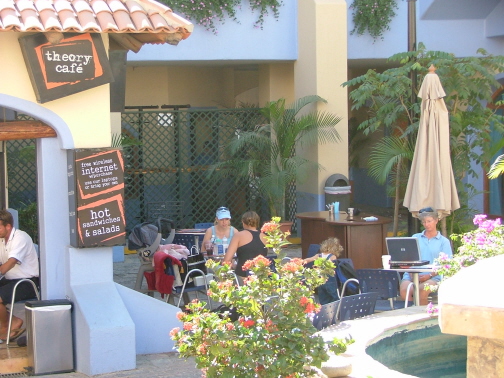
One of the many benefits of being in the marina was the existence of this nearby, open-air internet cafe' with free wireless connection service. It was from here that we received our email and uploaded the Baja web page. It also had a great mascot, an English Bulldog that liked to spread-eagle himself on the cool tile floor.
Kay is seated at a table on the right, using our HP laptop to read her email.
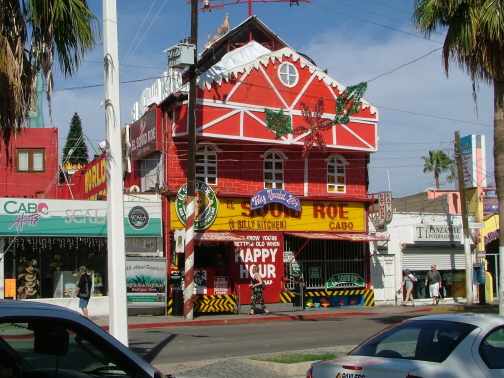
With our friends Chip and Kay on Beso, we went out to dinner the first night at one of Cabo's more infamous spots, Squid Roe. Apparently this place can get pretty wild later in the evening, but we had a very good meal in a relatively quiet atmosphere. It seems as though all of the waiters here are aspiring comedians, so it was an entertaining meal as well.
The second night we went to dinner at perhaps the oldest restaurant and hotel in Cabo, the Hacienda, which is right on the tip of the sand spit that forms the entrance to the harbor. Great food in a remarkable setting.
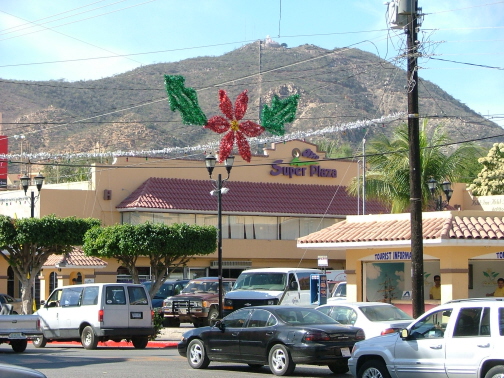
Cabo provided us with our first opportunity to visit a real supermarket since leaving Ensenada. Here's the Super Plaza, which is only a block and a half from the marina. Surprisingly, one can often find more US products on the Baja peninsula than on the mainland. Kay stocked up on a few items we weren't likely to see for a while.
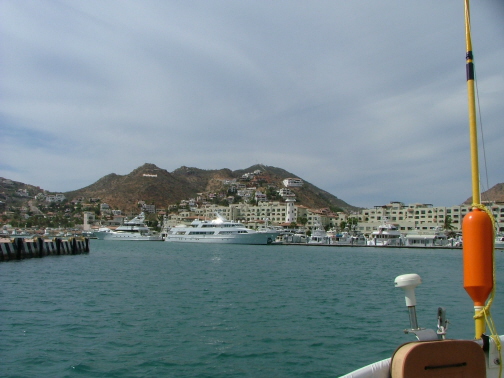
We spent just two nights in Cabo, mainly due to the expense. We could have anchored outside the harbor but it can be very rolly at times. We managed to get all of our tasks taken care of: laundry, reprovisioning, internet, washing all the Turtle Bay dust off the boat, and filling the tanks with fresh water.
Having spent two weeks here, anchored for free inside the inner harbor (directly astern of us in this photo) in 1991, we didn't feel cheated by our short stay.
The town has just exploded in size since we were last here. And if you go back to just the late 1960's, there was nothing here but the Hacienda Hotel and Restaurant and a dirt airstrip that ran right through the middle of what is now downtown Cabo San Lucas.
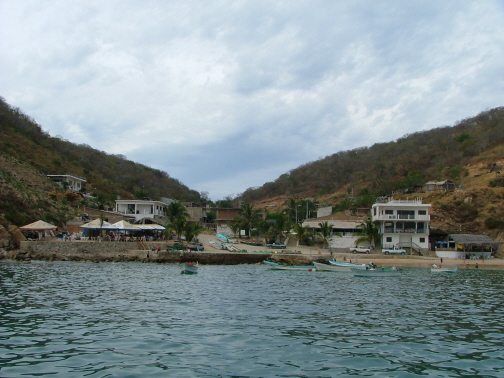
When we left Cabo, we thought we'd head in the general direction of Puerto Vallarta, over 250 miles across the Sea of Cortez, or as the locals prefer the Golfo de California. But half way and 24 hours into the two- day passage, we decided to skip "PV" on the way south, knowing that we'd be stopping there on our way north in the spring. This also allowed us to ease the sheets a bit and fall off on a more southerly heading.
The closest anchorage south of Banderas Bay (where Puerto Vallarta is located) is the very small bay called Ipala. When we were here in 1991, Steve's dad was with us. At that time, the town at the head of the bay, Tehuamixtle, looked kind of spooky, almost like a ghost town. We stayed aboard.
Now, in 2004, we found some new buildings and two or three restaurants (depending on whether you count the second floor of the white building on the right and the thatch covered palapa to the right of it as one or two). We had an early dinner at the tent-covered restaurant on the left--delicious Camarones a la Mantequilla (shrimp sauteed in butter).
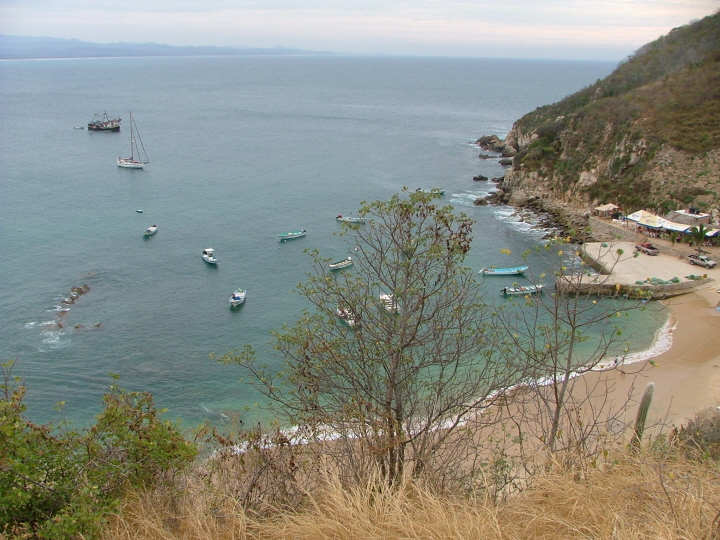
After our meal we hiked up the steep road through the village to get this photo of the anchorage with Kavenga and a shrimp boat anchored beyond the fleet of pangas.
On the hike up, we were surprised to find three or four little tiendas (small stores) selling basic grocery items. We bought some tasty coconut flavored cookies from one of them.
Our next day's destination, Chamela, lay just over the horizon, beyond the point in the distance.
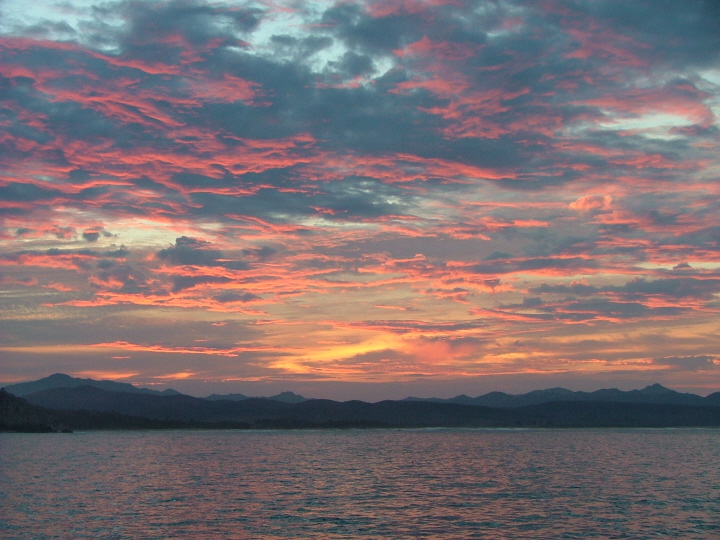
Along the west coast of Mexico, one is frequently treated to beautiful sunrises, such as this one at Ipala that greeted us as we departed the anchorage.
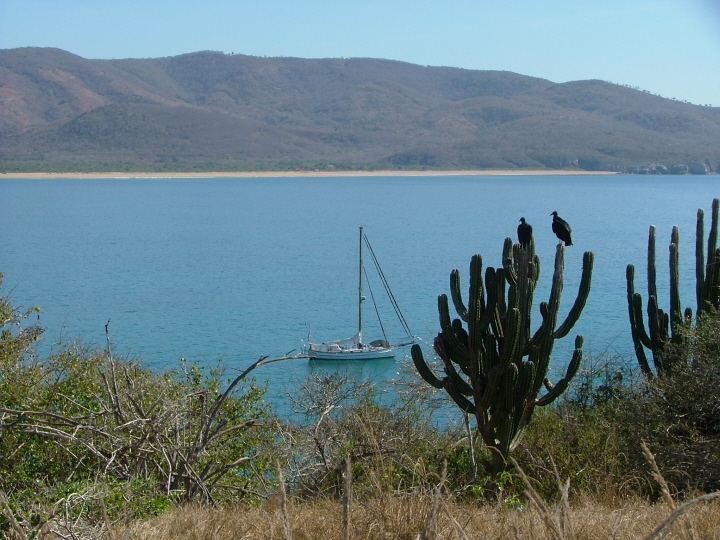 Having also been to Chamela in 1991, we were looking
to do something different this time. Bahia Chamela is a big bay
and in the middle of it are two large islands, Isla Passavera and
Isla Colorado. Isla Passavera has a small bight on its south side
offering decent protection from the mostly northwest swells. Not
many boats anchor overnight here, preferring the "community
anchorage" at the north end of the bay. Nevertheless, we
spent two peaceful nights anchored here.
Having also been to Chamela in 1991, we were looking
to do something different this time. Bahia Chamela is a big bay
and in the middle of it are two large islands, Isla Passavera and
Isla Colorado. Isla Passavera has a small bight on its south side
offering decent protection from the mostly northwest swells. Not
many boats anchor overnight here, preferring the "community
anchorage" at the north end of the bay. Nevertheless, we
spent two peaceful nights anchored here.
The island is a bird refuge although hikers are not prevented from going ashore as long as they respect the local flora and fauna.
The two large birds atop the cactus are vultures, very plentiful in Mexico.
You sailors may notice that we have our Code Zero drifter set aft of the headstay.
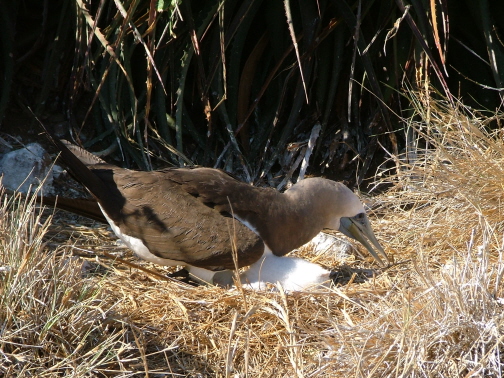
We saw many birds up close on Isla Passavera including this Yellow-footed Booby that is trying to hide its fluffy white chick from our prying eyes. We were somewhat surprised to see a chick in December. It seemed awfully early to us.
Most of the boobies that were on the ground or in bushes wouldn't move away unless we came within six feet of them. When they become displeased with your presence they sometimes fly at you, banking away at the last moment.
Like pelicans, they are dive bombers that plunge into the sea at high speed to attack the small fish they feed on. They will also go after flying fish above the surface as well as below. We started seeing flying fish again, somewhere in this area. We also began to find squid on deck that had been chased into the air by attackers from below.
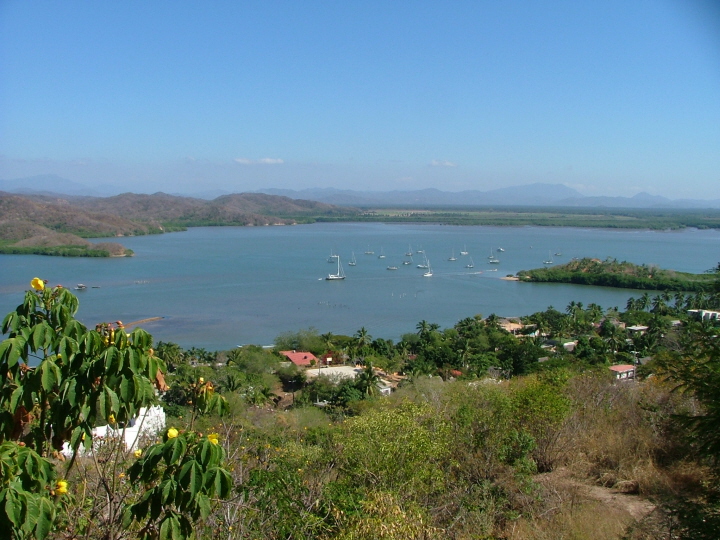 In 1991, our next stop after Bahia Chamela was the
very popular Bahia Tenacatita. But again we were looking for new
experiences and knew that we'd have another chance at Tenacatita
on the way back north.
In 1991, our next stop after Bahia Chamela was the
very popular Bahia Tenacatita. But again we were looking for new
experiences and knew that we'd have another chance at Tenacatita
on the way back north.
We decided to go just a little further to a place that "didn't exist" in 1991, at least it didn't exist as a possible anchorage. This is the lagoon behind Barra de Navidad. Until a few years ago the channel leading into the lagoon was very shallow, barely six feet and considered navigable by small boats only. According to third-hand information, the channel was dredged out to facilitate the filming of the movie "McHale's Navy" (parts of it were also filmed at Tenacatita).
In any case, it is now possible, with careful navigation to enter the lagoon and anchor in 10 to 12 feet of water. The reason everyone is anchored in what appears to be a tight cluster, is that the water becomes too shallow for safe anchoring much beyond the boats seen anchored here.
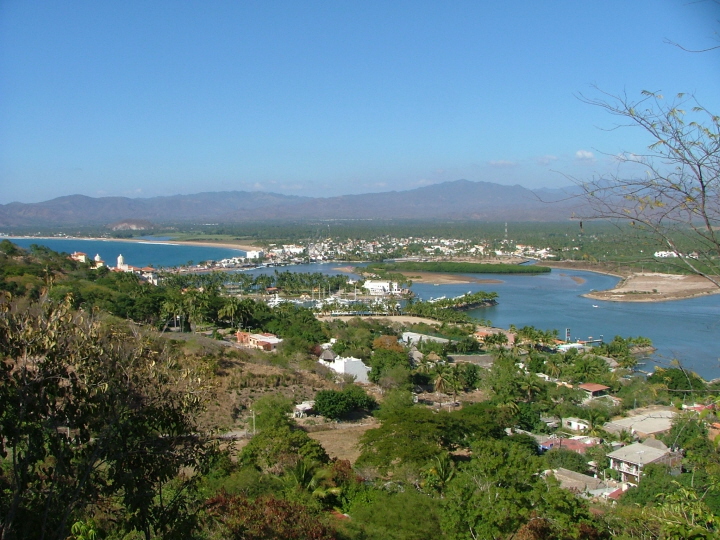 Here's a view of the town of Barra de Navidad
(Christmas Sandbar) on the far side of the channel to the lagoon.
Here's a view of the town of Barra de Navidad
(Christmas Sandbar) on the far side of the channel to the lagoon.
Barely visible on this side of the channel is Marina Barra de Navidad. You can see a few masts poking up. However, the majority of the slips are occupied by power vessels, some of them huge.
The open Pacific is just beyond the sandbar on the left. In the far distance is the old resort town of Melaque, which although most of its hotels are not up to today's standards, still draws a lot of bargain-hunting tourists. We took a bus there to pay our port fees.
The entrance to the lagoon is on the right. To get to town we'd come in around the spit on the far side in our dinghy and continue around the green island to the Sands Hotel on the far shore.
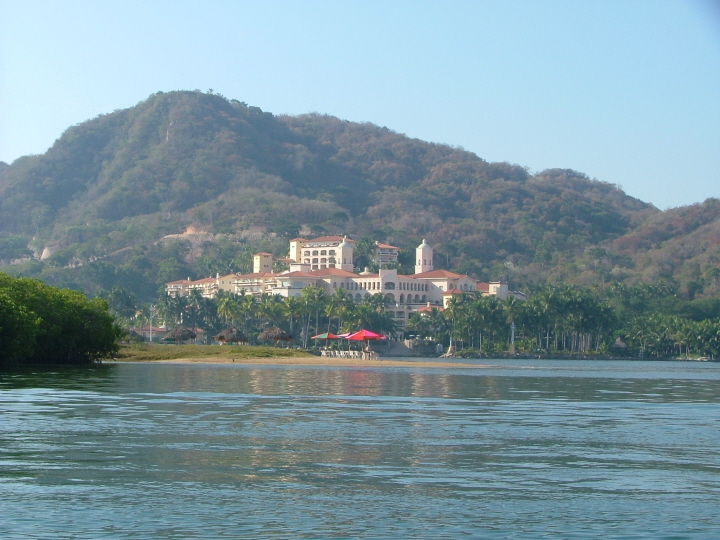 Just out of sight in the above photo, adjacent to
the marina, is the amazing Grand Bay Hotel. In this shot the
marina is just out of sight to the left.
Just out of sight in the above photo, adjacent to
the marina, is the amazing Grand Bay Hotel. In this shot the
marina is just out of sight to the left.
We've seen other luxury hotels in Mexico and the Bahamas that surely rival this one in facilities, but there is just something about the Grand Bay that makes it a little special.
Maybe it's the isolated location across the channel from the town.
At any rate, it's a bit of Shangri-la where you will be pampered and entertained to your heart's content--for $400+ per night.
Guests at the marina are permitted to use the hotel's facilities. We are seriously considering a couple of nights in the marina on our way north for that very reason.
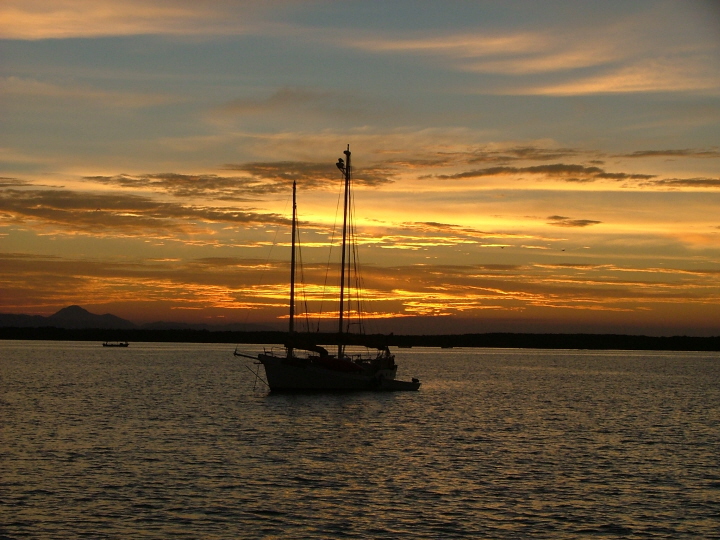
Here's a sunset shot of Gia, a junk-rigged schooner with the unlikely hailing port of Albany, Oregon, anchored astern of us in the Barra Lagoon.
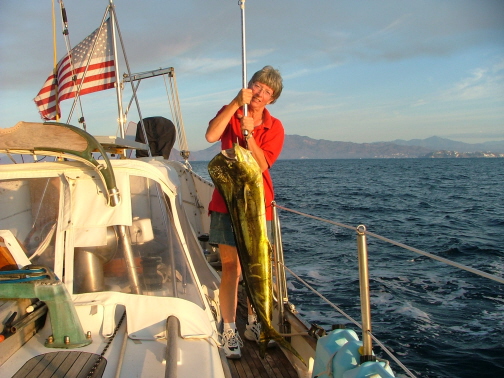
We finally tore ourselves away from Barra to continue our journey south and east to Zihuatenejo in a series of day-hops.
Our first stop was in the large Bahia de Manzanillo, which has several smaller bays within it. We anchored in two of them: Caleta Carrizal, and Bahia Santiago.
We neglected to take any pictures while we were there (we'll get another chance), but shortly after we left we had a "Kodak Moment" when Kay hooked and landed this big bull Mahi Mahi or as they call them down here, Dorado. This one taped out at 51 inches and weighed just shy of 25 pounds.
He put up a heck of a fight and yielded enough filet steaks for at least eight or more meals. Thus far we've had mahi steaks cooked in butter with slices of melted cheese on top, mahi-pasta salad, and mahi tacos--all delicious. Kay also took mahi-morsels as an hors d'ouerve to a cruiser get-together.
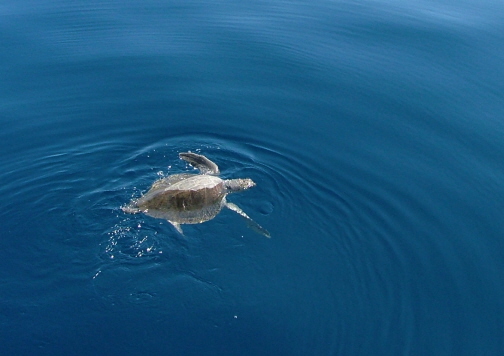
Later the same day, we entered an area seemingly teeming with sea turtles. Either they don't hear well or they are reluctant to move as several of them that were directly in our path did not move until the last possible moment, or they forced us to turn to avoid them. As such we were able to get a few photos of them from Kavenga's bowsprit, as they floated serenely on the placid, windless sea.
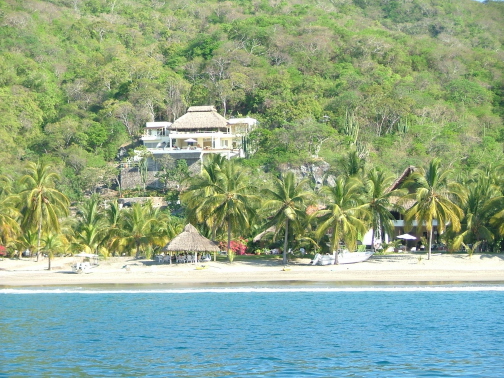
It was just as well that our stop here at Cabeza Negra (Black Head) was only intended as a one-night anchorage. Although it is beautiful here, it is a privately owned beach. The rich and famous from Guadalajara and Mexico City that occasionally live here are apparently very nervous about being kidnapped (see the movie Proof of Life). They have guards on the beach and a "harbormaster" who calls on the radio to welcome you and say that you are free to walk on the beach but not to wander back into the residential areas.
We opted to just enjoy the view and continue on our way the next day. This is just one of a half dozen or so of the fancy homes spotted around the small bay.
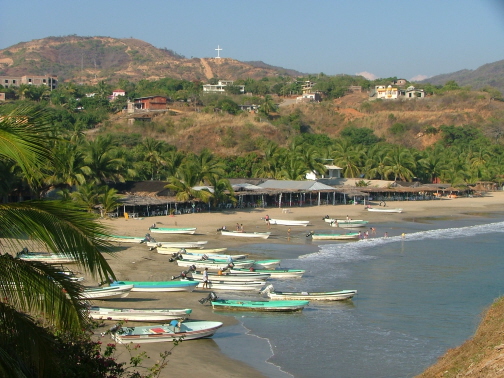
This charming little bay goes by two names. Some call it Caleta de Campos, others call it Bahia de Bufadero (Blowhole Bay). The latter is what is painted on the welcome sign on the inner side of the stone and cement seawall.
It can be very rolly in this bay depending on the size and direction of the swells. We had only mildly annoying swells during our visits, but other boats reported having to move out when larger swells came in and began breaking further out from the beach.
The structures on the beach are all open-air restaurants, or palapas, built side-by-side. We found a restaurant one block back from the beach recommended in one of our guides and had a delicious meal.
We also walked along the town's main drag and found it lined with a number of fresh produce stores.
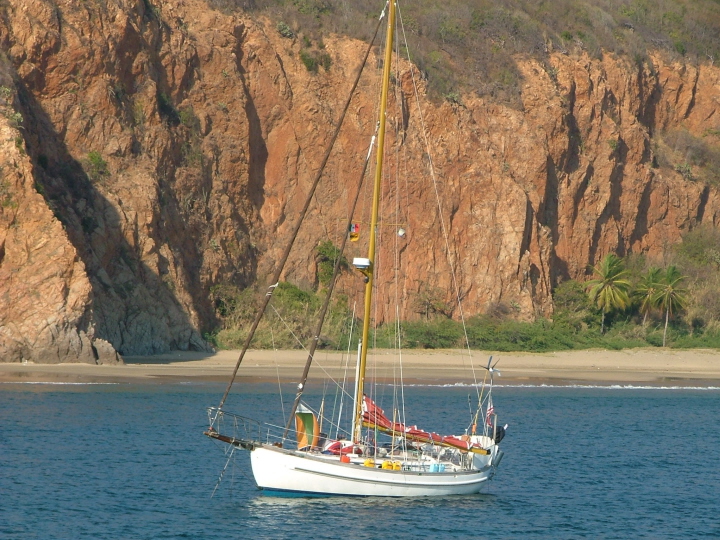
Here's Kavenga lying at anchor at Bahia Bufadero also known as Caleta de Campos..
A few things to note in this shot:
1) The Windscoop is set up over the foredeck hatch funneling the breeze belowdecks.
2) The boom is wung out to keep it from shadowing the four solar panels on top of the dodger.
3)Gas, diesel and water jerry cans are carried on deck
4) The Mahi Mahi flag is flying beneath the Mexican courtesy flag.
5) It's a picturesque spot.